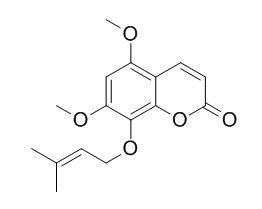Artanin
Artanin displays promising inhibition against both MSSA and MRSA with minimal inhibitory concentrations (MICs) of 8-64 ug/ml, but very weak against Gram-negative pathogen and yeast with MICs of 256 to ≥1024 ug/ml.
Inquire / Order:
manager@chemfaces.com
Technical Inquiries:
service@chemfaces.com
Tel:
+86-27-84237783
Fax:
+86-27-84254680
Address:
1 Building, No. 83, CheCheng Rd., Wuhan Economic and Technological Development Zone, Wuhan, Hubei 430056, PRC
Providing storage is as stated on the product vial and the vial is kept tightly sealed, the product can be stored for up to
24 months(2-8C).
Wherever possible, you should prepare and use solutions on the same day. However, if you need to make up stock solutions in advance, we recommend that you store the solution as aliquots in tightly sealed vials at -20C. Generally, these will be useable for up to two weeks. Before use, and prior to opening the vial we recommend that you allow your product to equilibrate to room temperature for at least 1 hour.
Need more advice on solubility, usage and handling? Please email to: service@chemfaces.com
The packaging of the product may have turned upside down during transportation, resulting in the natural compounds adhering to the neck or cap of the vial. take the vial out of its packaging and gently shake to let the compounds fall to the bottom of the vial. for liquid products, centrifuge at 200-500 RPM to gather the liquid at the bottom of the vial. try to avoid loss or contamination during handling.
Eur J Pharmacol.2024, 981:176883.
Chemical Engineering Journal2024, 500:157110
ACS Omega.2024, 9(41):42227-42244.
Daru.2024, 32(2):689-703.
Anticancer Res.2022, 42(9):4403-4410.
Molecules.2022, 27(22):7887.
Nat Commun.2019, 10(1):5169
Sci Rep.2017, 7:467-479
Int J Mol Sci.2021, 22(14):7324.
Oncol Rep.2021, 46(2):166.
Related and Featured Products
Phytomedicine. 2016 Dec 15;23(14):1814-1820.
Synergism of coumarins from the Chinese drug Zanthoxylum nitidum with antibacterial agents against methicillin-resistant Staphylococcus aureus (MRSA).[Pubmed:
27912884 ]
This study is to present in-depth evaluations of in vitro antimicrobial activities of four natural coumarins 5-geranyloxy-7-methoxycoumarin (Gm, 1), (5,7-dimethoxy-8-prenyloxycoumarin (Artanin, Ar, 2)), isopimpinellin (Is, 3) and phellopterin (Ph, 4) from Zanthoxylum nitidum (Roxb.) DC. (Rutaceae) extracts, focusing on their potential restoration the activity of conventional antibacterial agents against clinical MRSA strains.
METHODS AND RESULTS:
Bioactivity-guided fractionation and spectral analyses were used to isolate the coumarins and identify the structures, respectively. The double broth microdilution method was used to assay the coumarins' alone activity. The classic checkerboard microdilution and dynamic time-killing methods were used to evaluate combinatory effects. The four plant coumarins Gm (1), Ar (2), Is (3) and Ph (4) were isolated and identified from Z. nitidum extracts. Coumarins 1-4 displayed promising inhibition against both MSSA and MRSA with minimal inhibitory concentrations (MICs) of 8-64μg/ml, but very weak against Gram-negative pathogen and yeast with MICs of 256 to ≥1024μg/ml. The geranyloxy and prenyloxy substitutions showed to be more active than the methoxy substitution on the coumarin skeletons. 1-4 also showing different extent of synergism with a total of eight conventional antibacterial agents, i.e. chloramphenicol (CL), gentamicin (CN), fosfomycin (FF), levofloxacin (LE), minocycline (MI), piperacillin/tazobactam (P/T), teicoplanin (TE) and vancomycin (VA) against ten clinical MRSA strains.
CONCLUSIONS:
Four to ten of the tested MRSA strains showed bacteriostatic synergy in the eleven combinations.
Tetrahedron.2008 May;64(19):4438–4443.
Total synthesis of naturally occurring 5,6,7- and 5,7,8-trioxygenated coumarins.[Reference:
WebLink]
METHODS AND RESULTS:
The synthesis of five naturally occurring polyoxygenated coumarins is described. It concerns two 5,6,7-trioxygenated coumarins, i.e., 6-hydroxy-5,7-dimethoxycoumarin (fraxinol) 1 and 5,6,7-trimethoxycoumarin 2, and three 5,7,8-trioxygenated coumarins, i.e., 8-hydroxy-5,7-dimethoxycoumarin (leptodactylone) 3, 5,7,8-trimethoxycoumarin 4 and 8-(3-methyl-2-butenyloxy)-5,7-dimethoxycoumarin (Artanin) 5.
CONCLUSIONS:
Key feature of the synthetic pathway is the synthesis of suitable tetraoxygenated benzaldehydes, which are then converted to the corresponding coumarins via a Wittig reaction.



